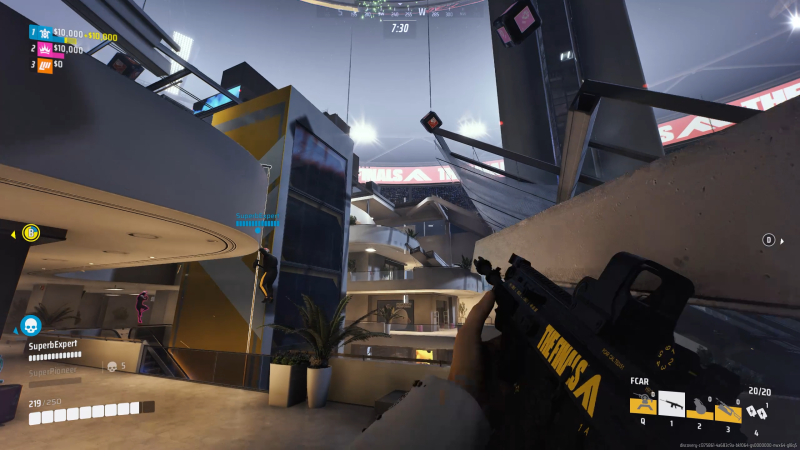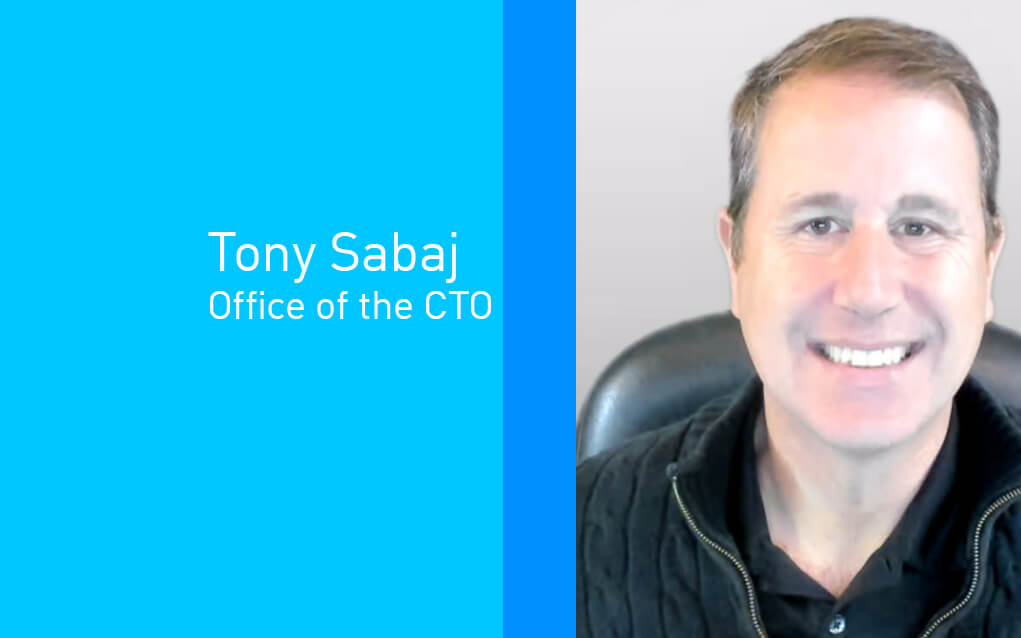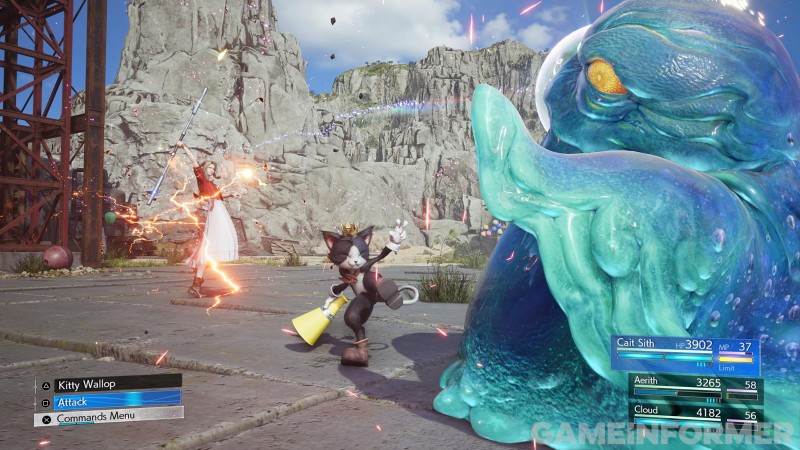As the aviation industry moves toward net zero emissions by 2050, sustainable aviation fuel is one of the…
Enzymes Can’t Tell Artificial DNA From the Real Thing – Technology Org
UC San Diego researchers are exploring how to add letters to the genetic alphabet to make never-before-seen proteins….
Challenge: Direct Methanol Synthesis from CO2 – Technology Org
ExxonMobil, the Seeker for this Challenge, is interested in finding novel processes for direct conversion of CO2 to methanol…
The Finals Review – Appetite For Destruction – Game Informer
The Finals offers rare novelty in the competitive multiplayer genre, encouraging creative strategies impossible in other titles because of its immense environmental destruction, physics-based hazards, and armory of whimsical gadgets. This first-person shooter occurs amid a digital game show where varying counts of three-person teams fight over money caches in an objective-focused format. The Finals is unpredictable in the best way: gameshow events like meteor showers or orbital lasers remap previously memorized paths, map variants like moving platforms or suspended structures can obfuscate objectives, and your team’s best-laid defensive plans are often interrupted as explosives obliterate the buildings around you.
Developer Embark Studios showcases its mastery of Unreal Engine with gorgeously lit, fully destructible level designs that are incredibly fun to maneuver. Monaco, Las Vegas, Seoul, and Skyway Stadium – the four maps present at release – require distinct strategies and feature randomized elements that make every match impressively dynamic. You might load a map and find it under construction or unrecognizable, such as when sandstorms cover Vegas with enormous dunes.

The game features three unique classes: Heavy, Medium, and Light. Heavies can equip a rocket-propelled grenade, flamethrower, energy shield, a massive sledgehammer, or a glue gun that allows the user to create makeshift walls and cover. Mediums most closely resemble a support role, featuring the option to equip a healing beam, automated turret, zipline systems, jump pads, and defibrillators for quick revives. Lastly, the Light class specializes in grappling hook traversal and multiple invisibility gadgets. Each role is satisfying to explore, offering numerous possibilities for emergent play. Witnessing brilliant synergies like propelling the Cashout – an ATM-like objective – toward the opposite side of the arena by using the Heavy’s rocket to bounce the object atop a Medium’s well-placed jump pad leaves me energized and curious. Ultimately, team collaboration is crucial in finding success in The Finals since the skill ceiling becomes much higher with these potent equipment combinations.
It’s incredibly satisfying to interrupt an enemy team’s attempt at stealing the objective (an ATM-like device) by blowing the floor from beneath them with an RPG or C4 pack and ambushing them as they unexpectedly fall to a lower level. On the flip side, you can avoid a perilous fall with a well-timed goo grenade, creating a makeshift floor or bridge where one didn’t exist before. The reactive, high-stakes strategies the physics system facilitates remind me of the breakneck decisions that define the best fighting games.

Ignoring current multiplayer trends, The Finals features sturdy health bars, long respawn times, the exclusion of multiple weapon slots, and a lack of scopes on most guns. While using the iron sights on larger weapons like the M60 light machine gun is sometimes tricky because the optic’s alignment markers obscure my view, I admire Embark’s commitment to novelty through these choices, as they reinforce a focus on gadgets, environmental destruction, and the creative strategies that emerge from the intersection of those features.
However, in a game with many well-designed characteristics, Embark’s use of generative A.I. text-to-speech voicework is unappealing. The gameshow’s characters sound believable at best but broadly fall flat due to one-note performances and mediocre writing. Additionally, I’ve heard duplicate voice lines multiple times, making the developer’s use of generative art largely pointless.
Notably, the cosmetic microtransactions are fairly priced and offer robust character customization. Whether earning a new skin via the battle pass or purchasing it from the in-game shop, you can equip various parts of the outfit and pair them with others. Despite the slow progression of the battle pass, which I hope is adjusted in the future, the mix-and-match nature of its rewards makes them exciting to unlock.
The Finals has given me some of my favorite multiplayer moments in 2023. Whether actively engaging in vertical combat or excitedly scaling rooftops on the way to the next objective, navigating the environments feels incredible, and the thrill of watching the ground disappear from below my feet never gets old. In a year of groundbreaking video game releases, The Finals is yet another highlight.
Expert Tony Sabaj on Managed Security Service Providers – CyberTalk

Anthony (Tony) Sabaj is currently the Head of Channel Security Engineering for the Americas at Check Point, with over 25 years of experience in the Cyber/Information/Network security. Tony has been at Check Point since 2002 in a variety of sales and technical roles. Prior to joining Check Point, Tony was a Senior Product Manager at Telenisus, a startup MSSP/VAR in Chicago. In 2001, the MSSP business of Telenisus was sold to Verisign to start their MSSP business and the VAR business was sold to Forsythe to start their security practice. Tony joined Forsythe shortly after that acquisition as a Security Consultant and Certified Check Point trainer. Tony started his career with Arthur Andersen/Andersen Consulting, building their worldwide IP network, designing the security controls for the firm and helping to build their external security consulting practice.
In this interview, Tony Sabaj discusses the adoption of Managed Security Service Providers (MSSPs). From selecting an MSSP provider, to the opportunities and challenges that come with relying on MSSPs, this interview provides in-depth cyber security insights.
These days, what types of organizations are newly seeking out managed security service providers (MSSPs)?
Organization are taking advantage of MSSP for a variety of reasons, including economies of scale, access to experts and tools that are otherwise out of reach for many organizations. With the rise of As-a-Service offerings, especially cloud consumption, MSSPs can more easily accommodate fluctuating demand that most organizations cannot economically accommodate. An MSSP can allow an organization to consume services and solutions on an as-needed or pay as to go basis, alleviating the need for the organization to build capacity for their peaks and allowing them to consume what services are needed based on demand at any point in time.
Broadly speaking, what should organizations look for in MSSP offerings?
The first thing organizations should look for is to make sure they are working with an MSSP and not an MSP (Managed Service Provider). The basic difference is that an MSP will manage devices or applications for uptime, health, and directed move/add/changes. Whereas an MSSP is providing the security expertise As-a-service, creating security policy, security monitoring and response to security incidents. Secondly, organizations should look for expertise in their specific field/vertical. There are security controls that are universal for almost all organizations, but —especially when it comes to compliance and governance— the security controls differ based on industry. Make sure that an MSSP is taking into account regulations or frameworks that an organization needs to adhere to, including ISO 27001, HIPAA, PCI, GDPR, and NERC, just to name a few.
Where can MSSPs assist organizations in saving on security costs?
MSSPs have the ability to be more efficient with the utilization of resources; human resources, technology resources and processes are delivered and utilized with efficiency that is unmatched by most organizations. Because an MSSP delivers As-a-service, there are fewer upfront costs for an organization, freeing up capital to be invested in other areas of the organization.
How can managed security relieve the strain on IT resources?
Seventy-six percent of organizations report a cyber security skills gap. Obviously, there is a shortage of qualified cyber security professionals. MSSPs can bridge that gap by providing an in-demand skill set at an economy of scale that is difficult for most organizations to match.
Also, utilizing the right MSSP can allow an organization to focus their resources on the products and services of that particular organization. Further, since most security incidents require quick and agile response, an MSSP will have the capacity on-hand to adequately respond, in collaboration with a group of experts, something that most businesses cannot otherwise afford.
Is working with an MSSP always a magic bullet type of solution?
It is never a magic bullet for any organization. Utilizing an MSSP has many advantages, but also comes with challenges.
Opportunities?
Besides the aforementioned benefits, an MSSP will have broader knowledge of the cyber security space, access to the latest security tools, and will understand unknown security concerns, at least in relation to the client. Working with an MSSP allows an organization to pivot or migrate to other solutions faster than they would be able to in-house. Organizations that purchased, implemented, and trained staff with particular controls that no longer suit their needs are pretty much required to start over, to maintain multiple systems and to incur the upfront costs of a newer solution. By utilizing an MSSP, an organization can choose different solutions offerings from the MSSP or even switch MSSPs more quickly and more cost-efficiently.
Challenges?
In most cases, utilizing an MSSP does not transfer liability. The organization still needs to be vigilant and abreast of the cyber security posture of their organization. Ultimately, the organization is responsible for ensuring adequate protections are in place. With the recently passed U.S.-based legislation concerning reporting of material cybersecurity incidents, the responsibility lies with the organization to comply with governmental regulations, regardless of their usage of an MSSP.
Lastly, organizations need to inspect and ensure that a given MSSP offers clear reporting and metrics in relation to the services that they are providing.
| Did you find this interview informative? See our related resources |
Understanding Semantic Layers in Big Data
In the realm of big data, the ability to efficiently manage, interpret, and leverage vast amounts of diverse information is crucial. This is where the concept of a semantic layer comes into play, serving as a vital component in the architecture of big data systems. The…
Final Fantasy VII Rebirth Preview – How Cait Sith’s Combat Works – Game Informer
In Final Fantasy VII Remake, players had the chance to thoroughly explore the movesets of Cloud, Barret, Tifa, and Aerith through an extended stay in Midgar. Final Fantasy VII Rebirth adds several new playable party members. While we already covered how one of those new playable characters, Red XIII, controls (read more here), this time, we’re talking about another playable party member: Cait Sith.
The cat creature joins the party during the course of Final Fantasy VII Rebirth following a brief cameo in Final Fantasy VII Remake. Just like Red XIII, he becomes a playable character for the first time in the Remake trilogy in Rebirth. As the team began adapting the underappreciated character for gameplay fitting the Remake trilogy and, in particular, Rebirth, they looked towards Cait Sith’s original Final Fantasy VII mechanics.

“For Cait Sith, we wanted to keep intact the really fun elements from the original, like the dice attacks and the luck components in his battle play; that’s shown in Rebirth as well,” director Naoki Hamaguchi tells Game Informer. “Of course, given its very cute appearance, it’s going to have a more quirky and extravagant fighting style as opposed to the more orthodox battle style of Cloud.”
Battle director Teruki Endo agrees with Hamaguchi’s desire to rely heavily on the original elements prevalent in Cait Sith’s style. “It really goes back to looking at and analyzing what is at the core of these characters going back to the original,” Endo says. “For Cait Sith, there are these luck-based abilities; we really wanted to express these in Rebirth. Starting from there, we would then build upon it with commands and actions we felt were suitable for this character. It’s not just the case for [new additions like] Cait Sith or Red XIII, but the same games for other characters like Cloud or Barret. Seeing what fighting style or battle experience players think of or imagine when playing as Cloud or Barret, and then analyzing this on a more micro level let us express it as we do in Rebirth.”

Cait Sith starts battle as a singular character, with the option to attack, perform a special ability known as Kitty Wallop, or use a luck-based command like Lucky Roll. However, the main differentiating factor for Cait Sith’s battle style lies in his ability to summon a secondary character to lend a hand and, in the process, change his combat mechanics completely.
“By calling a Moogle into battle, Cait Sith’s battle style will change,” Hamaguchi says. “You can jump off and control Cait on your own. In that case, the Moogle is just an A.I. character that battles on its own. When the HP is depleted to zero, it disappears, but you can call it again to make it appear again. There are attacks you can only do when you’re solo and not on the Moogle, but there are some that you can only do when you’re riding it.”
During a hands-off demo showing off a side mission (read more here), Hamaguchi, who is giving the demo, shows off Moogle Mine, an ability the Moogle can use while on the battlefield. This ability spreads mines within a radius of the Moogle, damaging any enemy that gets close enough to one. While I wasn’t the one controlling the action, it did seem to be a fairly impactful move from Cait Sith and the Moogle.

Red XIII also joins as a new playable character in Rebirth, bringing another distinct combat style
As with all party-character pairings, Cait Sith has Synergy Abilities with every other character in the party. Sadly, I only got to see one of Cait Sith’s Synergy Abilities, but if it’s any indication, we’re in for some fun interactions with the other characters in the party. Hamaguchi activates a Synergy Ability between Cloud and Cait Sith. The result is one of the zaniest attacks I’ve seen in the Final Fantasy Remake trilogy to this point. Cait Sith summons a Moogle, who grabs Cloud’s Buster Sword while Cloud rides on its back. Even as Hamaguchi touts the juxtaposition between Cloud’s more orthodox style and Cait Sith’s over-the-top, extravagant style, their combination in this Synergy Ability feels natural and fitting while also being completely wild and silly.
I can’t wait to play more of Cait Sith and learn how he interacts with the other characters when Final Fantasy VII Rebirth arrives on PlayStation 5 on February 29. For more on Final Fantasy VII Rebirth, be sure to check out our exclusive coverage hub by visiting the banner below!
The Best Of 2023 | All Things Nintendo

This week on All Things Nintendo, Brian and Kyle look back at 2023. The two talk about the good and bad the year had to bring the games industry before transitioning into an awards show format for the remainder of the episode.
[embedded content]
If you’d like to follow Brian on social media, you can do so on his Instagram/Threads @BrianPShea or Twitter @BrianPShea. You can follow Kyle on Twitter: @KyleMHilliard and BlueSky: @KyleHilliard.
The All Things Nintendo podcast is a weekly show where we celebrate, discuss, and break down all the latest games, news, and announcements from the industry’s most recognizable name. Each week, Brian is joined by different guests to talk about what’s happening in the world of Nintendo. Along the way, they’ll share personal stories, uncover hidden gems in the eShop, and even look back on the classics we all grew up with. A new episode hits every Friday!
Be sure to subscribe to All Things Nintendo on your favorite podcast platform. The show is available on Apple Podcasts, Spotify, Google Podcasts, and YouTube.
00:00:00 – Introduction
00:06:37 – 2023 Retrospective
00:18:36 – Best Strategy Game
00:23:02 – Best Action Game
00:31:02 – Best RPG
00:36:43 – Best Sports or Racing Game
00:40:29 – Best Party Game
00:44:15 – Best Platforming Game
00:49:04 – Best Indie Game
00:52:54 – Best Multiplayer
00:56:30 – Best Compilation
01:01:14 – Best Remake or Remaster
01:05:45 – Best Content Updates
01:09:37 – Better Late Than Never Award
01:12:06 – Most Wanted Game for Switch in 2024
01:18:23 – Best Third-Party Game
01:20:38 – Best Nintendo Game
01:25:19 – Grading Nintendo’s 2023
If you’d like to get in touch with the All Things Nintendo podcast, you can email AllThingsNintendo@GameInformer.com, messaging Brian on Instagram (@BrianPShea), or by joining the official Game Informer Discord server. You can do that by linking your Discord account to your Twitch account and subscribing to the Game Informer Twitch channel. From there, find the All Things Nintendo channel under “Community Spaces.”
For Game Informer’s other podcast, be sure to check out The Game Informer Show with hosts Alex Van Aken, Marcus Stewart, and Kyle Hilliard, which covers the weekly happenings of the video game industry!
